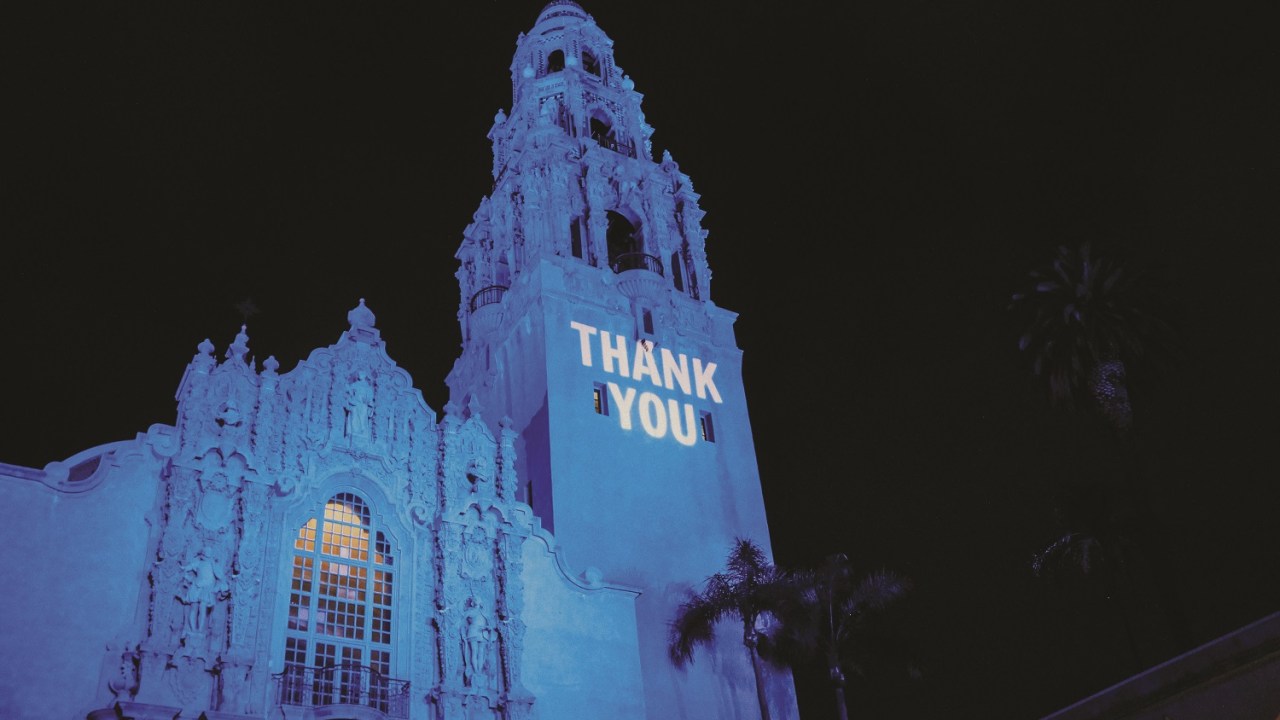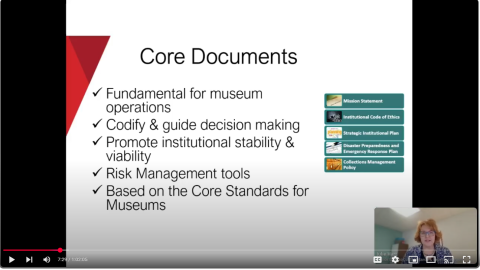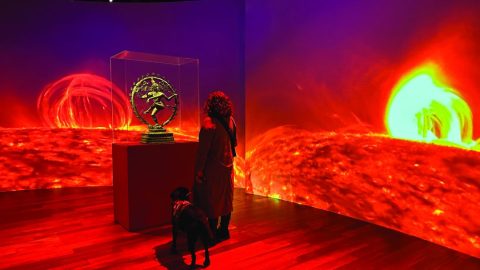
While for some museums the pandemic was a wake-up call to reimagine how they engaged and served their communities, for others it was an opportunity to go deeper. One of those museums, the Museum of Us, had been on a trajectory for several years toward becoming a more inclusive and less colonial institution. Then, with the catalyst of the pandemic, it accelerated that trajectory, seeking direction from the public, using its iconic building as a hopeful beacon, becoming a vaccine clinic and blood donation site, implementing an equity-based HR practice, creating a new “membership” model, and even changing its name (from the former “San Diego Museum of Man”). In recognition of these (and other) efforts, the museum was named a finalist for this year’s National Medal by the Institute of Museum and Library Services. To hear about the backstory behind this work, and how the museum’s team has stood up for progressive values against the obstacles, I caught up with Micah Parzen, the CEO of the Museum of Us. Below are excerpts from our conversation.
Adam Rozan: Let’s start by looking back to 2020, when the museum reached out to the public, to understand better how it could serve and help the people and community of San Diego and beyond. What did you all do, and what did you learn?
Micah Parzen: [The pandemic has] been a new beginning. It’s been a powerful springboard for many institutions to rethink who they are and what they stand for. At the Museum of Us, it was less about pivoting in a new direction and more about doubling down on the anti-racist and decolonial work we were already doing. The pandemic spurred us to fully commit to that work internally and in a far more public way.
Early in the pandemic, we struggled with, “Is my family okay?” “Are the people I’m responsible for at work okay?” “Am I okay?” We knew our community was not okay and felt compelled as an organization to ask, “Can we help in some way?” We remembered how, during World War II, the museum had been converted into a military hospital. We thought, “We have this space. We have this wonderful team who knows how to serve our community. What can we do?” Like every other museum, we were closed, so business as usual wasn’t an option.
Learn more about the museum’s decolonizing work and anti-racist work.
AR: Intuitively, we know that our communities have needs and often assume that we know, as practitioners, what’s best. But that’s not what the Museum of Us did in 2020. I think it’s also interesting that at that moment, the museum paused, knowing that your community was struggling. Rather than filling the void with online exhibitions, programs, etc., the museum paused and reached out.
MP: That’s right. Our years of community-centered work have taught us that we aren’t the experts. This was especially obvious relative to the high-stake unknowns of the pandemic. We didn’t know what was needed most nor what role, if any, we could play, so we asked our community for guidance. We called it our “Proposal to Serve Community Needs.” It was a one-page letter offering the museum as a community resource and asking for ideas about how we could best help.
We distributed the letter on various platforms and received hundreds of responses. Ideas ranged from serving as a morgue or a hospital again to a center for unsheltered folks, a mask-making facility, and everything in between. Ultimately, given our centralized location in the city, we decided that we could play a positive and productive role by serving as a food distribution site. So, we contacted the San Diego Food Bank, which had expertise in that space. We proposed a partnership, and they eagerly accepted.
AR: So, you put the call out, you get positive responses, and you try to move forward as a food distribution site, but unfortunately, you hit a roadblock. Can you share what happened and how the museum resolved it?
MP: Yeah, when we shared with the city that we were ready, willing, and able to serve our community in this way, they flat out said, “No.” Hard stop. The city had officially closed Balboa Park due to health and safety concerns, and no one from the public was allowed in—no exceptions. It was very frustrating and only reinforced that sense of helplessness.
But rather than giving up, we went back to the drawing board. We had created a “Pivot Planning Working Group,” consisting of board and staff, and we asked, “If we can’t open our doors to serve the community, what else can we do?” That’s when someone suggested we use our building and historic tower to share messages of support with the community. That weekend we began lighting up the California Tower in a dramatic blue with a projection of the words “THANK YOU.” It was a sight to see.
Later on, after the park finally reopened, the community had different needs than early in the pandemic. So, we partnered with the San Diego Blood Bank to become a much-needed blood donation site. And then, as vaccinations came out, we partnered with the Nursing Education Department at San Diego City College to serve as a COVID vaccination site. Our ability to be nimble became a superpower of sorts.
AR: Around the same time, the name of the museum changed from the San Diego Museum of Man to the Museum of Us. How does that storyline fit into all of this?
MP: Well, we had started down the name change path in earnest back in 2018, but due to a very prickly reaction from some in the community, we had put the project on an indefinite pause. We were paralyzed and couldn’t find a way forward. However, during the first few months of the pandemic, everything was so topsy-turvy, and people were dealing with so much change. It felt like a long-closed window had momentarily opened up, and we decided to go through it while we had the chance.
So, we worked with the staff and the board over several months, gathering input, figuring out how to address community concerns as best we could, and readying the organization for such a monumental change. Then, on August 2, 2020, we announced our new name, the Museum of Us, along with a new branding system, which included community members crossing out the word “Man” and writing in the word “Us.”
It felt like we had been standing at the edge of a cliff—harnessed up to our hang-glider, trying to muster the courage to jump—forever. When we finally took the leap and announced the new name, there was this incredible groundswell of love and support. We received hundreds of comments of heartfelt gratitude, from community members expressing how much the change meant to them and why.
And then Breitbart picked up the story. Soon after, Tucker Carlson highlighted the name change on national news as an example of political correctness run amok and woke cancellation culture at its worst. Then, the juggernaut of hate started, which led to quite the rollercoaster. But all that love and support buoyed us, and the dust eventually settled. Now we have a name that, yes, is part descriptive of our journey to date but, even more importantly, it’s aspirational. It challenges us to constantly ask what it means to be a museum not just for some of us, but for all of us. That’s the work ahead.
AR: What did you learn from all of this?
MP: Be clear about who you are and what you stand for as an organization. Whatever that may be will connect with some and not with others, but it will invariably lead people to ask themselves who they are and what they stand for. And that’s an invaluable role for any organization to play in its community. For a long time, we were a museum of people pleasers. We tried to make everyone happy, and it diluted our ability to truth-tell, apologize, and hold ourselves accountable for doing better. That lessened our ability to make an impact.
I don’t recommend this, but sometimes, I’ll read our social media reviews when I can’t sleep late at night. You have to take them with a massive grain of salt, but you can also learn a lot. With the Museum of Us, we generally get either five-star or one-star reviews. The five-star reviewers often share how we challenged their assumptions, got them thinking differently, and transformed them for the better. On the other hand, the one-star reviewers often lambast us as politically correct propaganda. What’s interesting, though, is that there is very little in-between. People seem to either love us—and can’t get enough—or they hate us and can’t get away fast enough.
I recently shared this observation with a colleague I respect and admire, and he said, “Micah, I think the Museum of Us is doing something right. Your work is either deeply resonating with visitors or touching a sensitive nerve. Either way, people are responding in passionate ways. Isn’t that exactly what museums should be doing these days?” That made a lot of sense to me.
AR: Fast forward, what does this mean for the museum, and how does this practically impact the San Diego community?
MP: Well, the goal is for everything to line up. We are constantly asking, “Does who we say we are on the outside match up with who we are on the inside? Where are the disconnects? Where are we coming up short?” Our team demands it. They let us know when we act in ways inconsistent with our values. They do it respectfully and productively, but they let us know. And I’m so grateful for that. It’s how we do better. We still make mistakes, of course, but our mistakes today differ from yesterday. That’s the definition of progress, not perfection.
Our community sees that, too. They see how we’ve changed. They see how we are trying to improve, even if we’re far from perfect. They see us as an organization that wants to be part of the solution instead of continuing to be part of the problem. They see us as an organization that wants to be an ally and is learning what that might look like. As a result, they are willing to extend us an extraordinary amount of grace in sharing their knowledge and lived experience as we continue down the path.
AR: How has your anti-racist and decolonial work translated into the organization and staff rebuilding?
MP: We are convinced that sustainable transformational change has to emerge from the inside out. That’s why we began to rebuild the museum from the people up. We knew the devastating suffering we had caused our team through the layoffs we instituted early on in the pandemic, and we wanted to make sure we emerged on the other side as a better version of ourselves.
So, when we reopened, we decided to hire back far fewer people, but at much higher wages and only on a full-time, fully benefitted basis. We established an entry-level salary of twenty dollars per hour, with guaranteed increases for our lowest-paid team members of 5 percent per year for at least three years and a 6 percent retirement contribution. That way, we stay ahead of the pay equity curve over time. We also established a salary cap wherein the highest-paid employee (namely, me) cannot earn more than six times the lowest-paid employee (namely, our forward-facing staff). Not so coincidentally, team member engagement and retention are the highest they’ve ever been at the museum.
Learn more about the museum’s staffing policies.
AR: Can you share more about the business side of the equation? How do you pay for it all?
MP: Well, we believe that if our business model has to cut human corners from the get-go to survive, then maybe we shouldn’t exist as an organization. Whereas most institutions are based on the premise that “more is more” on the outward-facing front, we have embraced a “less is more” approach. While it means we don’t turn over our exhibits as often and don’t have as many public programs as we might like, it allows us to take a “more is more” approach to investing in our staff and organizational culture. It may seem counterintuitive, but it’s critical when you are playing the long game.
Don’t get me wrong—I’m all for transformational exhibit experiences, too. But I also think museums are often overly focused on the visitor at the expense of their internal constituents. Think about it. Even the hardcore fans of your museum likely visit once a year, or maybe a handful of times, at most. On the other hand, our staffs, trustees, donors, and partners are in it deep. They show up at, and for, the museum regularly, if not every day. We are exponentially better positioned to impact them in transformational ways. And we see this all the time at the Museum of Us. Doing the work is—in and of itself—transformational in ways that transcend what our day-to-day visitors experience. So, we invest in the relationships with our staff, our board, and our community partners first and foremost. And it pays off in the long-run.
AR: We’ve discussed the museum’s staff; can you share what these changes mean for your audiences and the broader San Diego community?
MP: Okay, here’s an example. Before the pandemic, we’d long struggled with the very idea of museum membership. It always felt antithetical to our anti-racist and decolonial values. The more you pay to become a member, the more benefits you receive. It’s a hierarchical model where one’s degree of wealth directly translates into increased access and privilege.
So, when we reopened, we decided to turn that model on its head by creating a new program called Membership on Us. Now, anyone who comes into the museum and buys a day ticket can opt into a free program to visit whenever they want, however many times they want, over the course of a year. In other words, they become members on us for free.
We also have partnerships throughout San Diego County where students, teachers, and staff can become members on us without even purchasing a ticket. The same is true for Indigenous community members and financially disadvantaged folks. They are all welcome for free anytime.
Membership on Us has exponentially increased community access to the museum. Before the pandemic, we had one thousand members; today, we’re north of thirty-five thousand. Our next step is finding productive ways of bringing all those new members deeper into the fold of our anti-racist and decolonial work. It’s an exciting opportunity for us and for the community.
AR: I know we spoke about this before, but can you share more about how all this translates to your bottom line?
MP: Well, it’s really hard to make values-driven decisions that negatively impact your bottom line, that’s for sure. But there’s also something very uplifting about it. It reinforces those values in a way that brings even more clarity to the work.
So, if we need to end a revenue-generating loan agreement that dishonors the wishes of our Indigenous partners or “bless and release” a donor who bristles at our anti-racist and decolonizing initiatives, that’s what we do. We may have to press pause on a new exhibit or public program, delay the purchase of new gallery furniture, or wait on hiring for an open position until we can find a way to make it work, but it’s worth it.
Some funders have stopped giving to the museum because our values are no longer a fit with theirs. And that’s okay because so many others wholeheartedly believe in what we are doing and are doubling down on their support for our work. It hasn’t happened overnight, but we’ve bridged that gap, and then some. We’re always looking at emerging trends in the museum field, in philanthropy, and in society at large. Sometimes it feels like we are getting a little too far out on the limb, which can be scary, but we’d rather help create the future than react to it.








